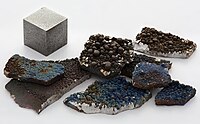
Photo from wikipedia
HighlightsMeasured Mn in drinking water, children's saliva, hair, and toe nails.Assessed neurodevelopment in children.Mn concentrations in drinking water are very low.Higher toe nail Mn associated with poorer Performance IQ scores… Click to show full abstract
HighlightsMeasured Mn in drinking water, children's saliva, hair, and toe nails.Assessed neurodevelopment in children.Mn concentrations in drinking water are very low.Higher toe nail Mn associated with poorer Performance IQ scores only in girls.Higher Mn in water associated with better Performance IQ scores only in boys. Background: Manganese (Mn) is an element found in the environment and certain geographic areas have elevated concentrations in soil and water du to natural conditions or anthropic activities. A growing body of data suggests that exposure to manganese in drinking water could be neurotoxic. Objective: Firstly, we aimed to examine the association between exposure to manganese from drinking water and cognition in children consuming well water. Secondly, we also aimed to examine the relation between cognition and manganese concentrations in children's hair, nail, and saliva. Methods: A total 259 children from 189 households consuming well water were included in the present study (ages 5.9 to 13.7 years). We assessed children's cognition with the WISC‐IV, and we used five indicators of manganese exposure: concentration in tap water, intake from the consumption of water divided by child's weight, manganese concentration in children's hair, toe nail, and saliva. We used General Estimating Equation analysis to assess the relation between manganese exposure indicators and IQ scores, adjusting for potential confounders, and taking into account family clusters. Results: Drinking water manganese concentrations were generally low, with 48% of children consuming water <5 &mgr;g/L, 25% >50 &mgr;g/L, and 4% >400 &mgr;g/L. Results differed by sex. In girls, higher manganese concentration in water, hair, and toe nail were associated with poorer Performance IQ scores but this was significant only for toe nail (for a 10‐fold increase in manganese, &bgr;: −5.65, 95% CIs: −10.97, −0.32). Opposite associations were observed in boys, i.e., better Performance IQ scores with higher manganese concentration hair, toe nail, and water, the latter being significant (&bgr;: 2.66, 95% CIs: 0.44, 4.89). Verbal IQ scores did not seem to be associated with manganese exposure indicators. Conclusions: Drinking water manganese levels were considerably lower than in previous studies reporting neurotoxic effects. There was no clear indication of an association between exposure to manganese and cognitive development in this sample of school‐age children although the data suggest there might be sex‐specific associations. Given the low levels of exposure and sex‐specific associations, a larger sample size would have been required to increase the statistical power and better characterize the relations.
Journal Title: Neurotoxicology
Year Published: 2018
Link to full text (if available)
Share on Social Media: Sign Up to like & get
recommendations!